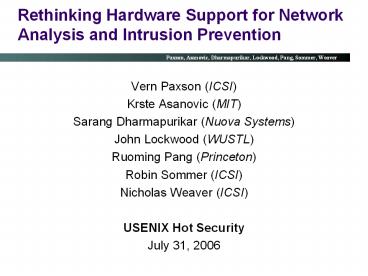Rethinking Hardware Support for Network Analysis and Intrusion Prevention - PowerPoint PPT Presentation
Title:
Rethinking Hardware Support for Network Analysis and Intrusion Prevention
Description:
Network Analysis Performance Pressures Growing in Multiple ... Goodbye to end-to-end semantics? Opinion: yep :-( Will parallel hardware progress sufficiently? ... – PowerPoint PPT presentation
Number of Views:31
Avg rating:3.0/5.0
Title: Rethinking Hardware Support for Network Analysis and Intrusion Prevention
1
Rethinking Hardware Support for Network Analysis
and Intrusion Prevention
- Vern Paxson (ICSI)
- Krste Asanovic (MIT)
- Sarang Dharmapurikar (Nuova Systems)
- John Lockwood (WUSTL)
- Ruoming Pang (Princeton)
- Robin Sommer (ICSI)
- Nicholas Weaver (ICSI)
- USENIX Hot Security
- July 31, 2006
2
Network Analysis Performance Pressures Growing in
Multiple Dimensions
- Increasingly, simple efficient signature
matching proves inadequate - False positives
- Polymorphism
- Zero-day attacks
- ? We need semantic application-aware analysis
- But that costs CPU (parsing) and memory (state)
3
Network Analysis Performance Pressures Growing in
Multiple Dimensions, cont
- Attacks inexorably grow in sophistication
- Arms race (particularly w/ attackers motivated by
) - Analysis also increasingly requires context (
state) - Problem of evasion leads to need to alter traffic
via normalization - so we need to operate in-line
- Plus we want to prevent attacks, not just detect
them - so we need to operate in-line
- We need to do a lot more processing .
4
Some Sobering Growth Trends
- Network traffic rates inexorably grow
- Network traffic volumes inexorably grow
- We need to do more analysis on larger amounts of
data at higher speeds - But CPU performance is NOT inexorably growing any
more.
5
Uniprocessor Performance (SPECint)
3X gap from historical growth
From Hennessy and Patterson, Computer
Architecture A Quantitative Approach, 4th
edition, 2006
? All major manufacturers moving to multicore
architectures
- General-purpose uniprocessors have stopped
historic performance scaling (no longer able to
leverage Moores Law) - Power consumption
- Wire delays
- DRAM access latency
- Diminishing returns of more instruction-level
parallelism
6
Where Will We Find The Performance??
- FPGAs!
- ASICs!
- Multi-core!
- Parallelism is here and is growing.
- Yes, thats what we will use
- but how?
- and at what labor cost?
7
Rethinking Hardware Support
- Current efforts in the literature SP01,FCH02,
MLLP03,LMK03,CS04,SP04,CMS05,LNZ03,
DKSL04,DL05,TSCV04,TS05,SL03,SML04,AL05 focus
heavily on supporting signature-matching - TCAMs, FPGA features, Bloom Filters for string
lookups - NFAs, DFAs, Aho-Corasick for reg-exp matching
- Nearly stateless
- Essentially Snort in hardware
- Rudimentary stateful analysis - TCP stream
reassembly w/ adversaries - unexamined in
literature until USENIX Security 2005 - Commercial designs may be ahead diff. to know
8
How Do We Get
- Stateful analysis
- State management in presence of adversaries
- Semantic rather than syntactic analysis
- Including at semantic layers spanning multiple
connections, hosts, applications - In-line processing for normalization, intrusion
prevention - expressed so it can leverage tomorrows
massively parallel processors? And without
having to code for hardware specifics?
9
Task-Level Parallelism inNetwork Analysis
Note Parallelism means individual forwarding
latency neednt be ?secs. Cycle budget can be
msec.
10
Architectural Vision
- Express high-level (semantic, app-aware, global
context) analysis using a high-level language - E.g., Bro intrusion detection system
- Compile these expressions to an abstraction of
parallelism - E.g., Transactors
- Retarget these abstractions to different,
specific hardware instances (FPGAs, multi-core)
to leverage their capabilities and resources
11
The Transactor Abstraction for Parallelism
AAC05, GSA06
- Network of computational elements
- Loosely coupled via FIFOs
- No timing guarantees between elements
- Transactor unit includes
- Local architectural state (persists across
transactions) - Buffered input/output channels
- Set of transactions (code) that executes
atomically - Scheduler that mediates execution messaging
- Computation always has a serializable equivalent
- Properties strive for efficient execution and
verifiable specifications
12
The Transactor Abstraction for Parallelism, cont
13
Expressing High-Level Network Analysis
- At lowest level, handcode analysis primitives for
Transactor parallelism abstraction - Connection state management, checksum validation,
stream reassembly, network/transport
normalization - At mid-level, construct application protocol
analyzers in a custom language (e.g., BinPAC, to
appear IMC 06) - Takes specification of Binary ASCII protocols,
compiles to C - Retarget to compile to Transactor abstraction
- At high-level, express analysis in custom
language (e.g., Bro) and likewise retarget
14
Challenges
- Development of high-quality optimizing compilers
- For high-level analysis protocol parsers ?
Abstraction - For Abstraction ? hardware instances
- Management of state and timers
- Private vs. shared memory
15
Possibilities
- A lot of work. But if achieved, can open up
network security analysis to much richer and
resilient set of capabilities. - Furthermore, consider that just about all of the
components are not specific to network security
analysis but just network analysis in general - HW supporting such analysis in-line can change
the paradigm of what network forwarding means - No longer send along packets w/ minimal cycles
- Rather enable rich, in-depth transformation as
the norm
16
Discussion
- Goodbye to end-to-end semantics?
- Opinion yep -(
- Will parallel hardware progress sufficiently?
- Just one weak link and Amdahls Law bites you
- I.e., can we really keep the processing pipeline
full flowing? - Maybe the right answer is a completely different
(and inherently parallelizable) model of
detection? - Opinion deep knowledge of app semantics is
fundamental, remainder follows from that - More fundamental parallelism push work out to
edges - But how the heck to trust them?

